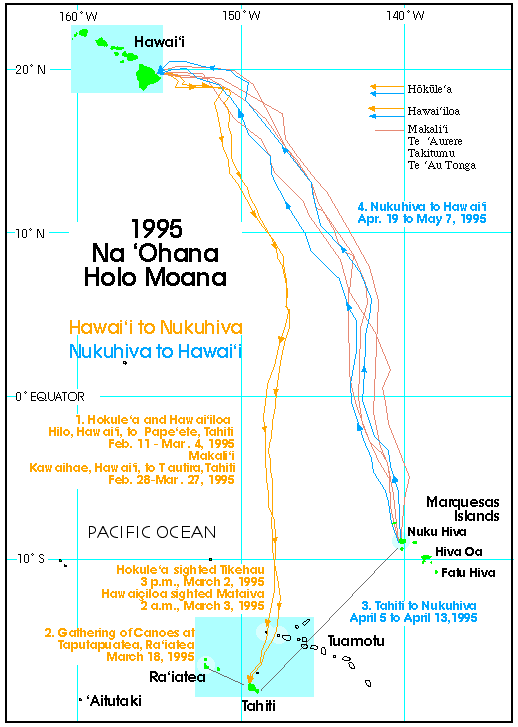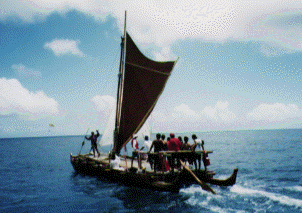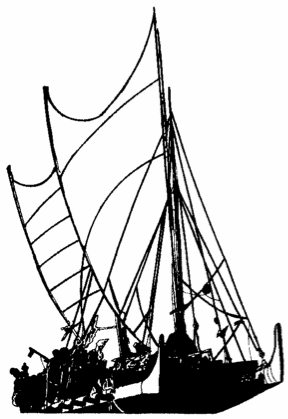PVS Newsletter / Kau (Dry Season) 1995
A Safe, Successful 1995 Voyage
Hawai‘iloa and Hokule‘a departed from Hilo on February 11 and arrived back in Hakipu‘u in Kane‘ohe Bay on May 11. It was the fifth voyage to the South Pacific for Hokule‘a, and the first for Hawai'iloa. A third Hawaiian canoe, built and sailed by Kalaiwa'a Moku o Hawai'i and named Makali'i after the constellation Pleiades, departed Hilo on February 28 and also arrived back with Hawai'iloa and Hokule‘a.
Hawai'iloa and Hokule‘a made Tahiti in 21 days, the fastest times for modern Hawaiian voyaging canoes so far. Past voyages have taken up to a month. The canoes did not encounter doldrums conditions in the Intertropical Convergence Zone and averaged 5.2 knots for the voyage. Hokule‘a sighted land first-the island of Tikehau in the Tuamotus at 3 p.m. on March 2; eleven hours later Hawai'iloa saw the lights of Matahiva and hove to. The two canoes entered Pape'ete harbor together on March 4.
Makali'i, which departed two weeks after the first two canoes, ran into doldrum conditions and arrived in Tahiti after 28 days, on March 27, averaging 4.1 knots for its voyage.
Hawai'iloa and Hokule‘a visited Mo‘orea, Huahine, and Ra‘iatea, where they participated, along with the Tahitian canoe Tahiti Nui and the Maori canoe Te Aurere, in the rededication of the marae of Taputapuatea and the re-establishment of an ancient Polynesian voyaging alliance, After a short visit to Taha'a the canoes went to Tahiti, where they were joined by Makali'i and two Cook Island canoes, Te Au o Tonga and Takitumu.
All the canoes departed under tow for Nukuhiva in the Marquesas Islands on April 5. After a welcome ceremony and cultural events in Taiohae and a short visit to the island of Ua Pou, the Hawaiian, Maori, and Cook Islands canoes left for Hawai'i on April 20, retracing this ancient migration route.

Biting flies were reported aboard three of the canoes on May 3. Canisters of insecticide were airlifted to the canoes. The canoes were sprayed 150 miles offihore; sprayed again when they approached Hilo; and sprayed a third time after they docked at Hilo. PVS was praised in the news media for acting quickly to insure the biting flies would not be introduced to Hawai'i.
From Hilo, the canoes sailed to O'ahu, stopping at Kaunakakai, Moloka'i. The crews were officially welcomed home at Hakipu'u in Kane'ohe Bay on May 11 and at Ke'ehi Lagoon on May 13.
Hawai'iloa was navigated by Chad Baybayan and Bruce Blankenfeld to Tahiti and by Blankenfeld, assisted by Kimo Lyman and Max Yarawamai, from Nukuhiva to Hawai'i; Hokule‘a was navigated by Ka'au McKenney and Keahi 'Omai to Tahiti and by Chad Baybayan, assisted by Moana Doi and Pi'ikea Miller, back; Makali'i was navigated by Shorty Bertelmann, assisted by Ka'onohi Paishon, to Tahiti and back; Clay Bertelmann served as Makali'i's captain for the voyage.
The voyage of Hawai'iloa and Hokule‘a to Tahiti and Nukuhiva was a project of the Bishop Museum Native Hawaiian Culture and Arts Program in cooperation with PVS. NHCAP was fiinded through a cooperative agreement with the National Park Service.
A New Canoe Named "Tutu"
A new koa canoe named "Tutui" was launched at Ala Wai Canoe Halau on May 29, 1995. The log came from the koa forest in South Kona by permission of the Greenwell Estate. It was roughed out by Mr. Antone Grace, a Kahuna Kalai Wa'a, and Mr. Frank Henriques about 1965. Mr. Henriques gave this roughed out log to his friend Wallace Froiseth about 1970. Later, after the passing of Mr. Henriques, the gift was honored by his son Ernest and brought to O'ahu from Kealakekua. The koa log was at Makaha for about 20 years.
In August of 1994 the log was brought to pier 36 and work was begun to make a racing canoe that would meet the requirements for competition. Work was done by Wallace Froiseth and his daughter Luana, with the help of Phillip Naone, Richline Fong and Catherine Fuller. Structural work was completed by February 1995. The canoe was water-lined, met the specifications to race and weighed in at 390 lbs. on May 16, 1995. The surface finish work was completed by Luana and Richline at pier 19.
The name, "Tutu," was given by Wallace Froiseth for two reasons. First, to honor Lahela Brown who was the greatest booster of the Waikiki Surf Club during its inception and early years. Secondly, in honor of Moku, Wallace's wife of 46 years, whom he lovingly calls "Tutu." This canoe is a work of aloha by all. The canoe will be in the charge of Luana Froiseth and loaned to the Waikiki Surf Club for use in racing competition .The koa log "Tutui" was alive on the ‘aina; now it will be alive on the sea.
Exploration Learning Center 1995
Exploration Learning Center / E'ala Project continued for its second year in the spring of 1995, funded by the Hawai'i Community Foundation. Students from Wai'anae High School's Marine Science Program, Hilo High School, and Konawaena High School, participated in the program along with students from Ka'fi, Nii Pua Noeau, and Kamehameha Schools' Hale o Ho'oponopono.
After training with Kahualaulani Mick and Angel Pilago, the Big Island students sailed E'ala along the Kona Coast in April; the Wai'anae students sailed the canoe from Maunalua Bay to Poka'i Bay in May.

Eala
HEI / Young Brothers donated barging to and from the Big Island. Hawaiian Catamaran donated craning and a trailer. Numerous canoe clubs and community organizations such as the Wai'anae Hawaiian Civic Club came out to support the students in their achievements.
The students also participated in the homecoming ceremonies for Hawai‘iloa, Hokule‘a, and Makali‘i and the Polynesian canoes at Hakipu'u & Ke'ehi Lagoon in May.
PVS Officers and Board of Directors
Officers: Myron "Pinky" Thompson, President; Kapua Lindo, Vice President; Virginia Elliott, Treasurer
Directors: Gilbert Ane, Moku Froiseth, Wally Froiseth, Harry Ho, Rey Jonsson, Eric Martinson, Jerry Muller, Laura Thompson, Michael Tongg, Nathan Wong, Bob Worthington, August Yee
Consultant: Ben Finney

